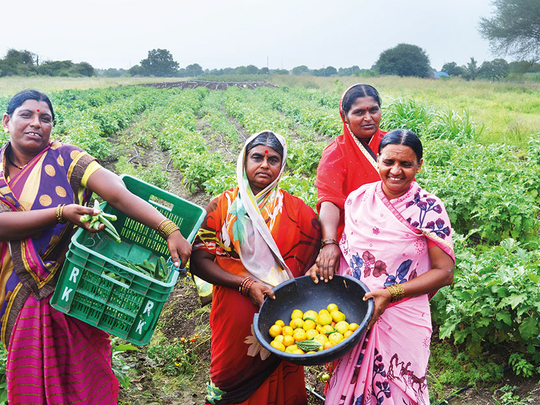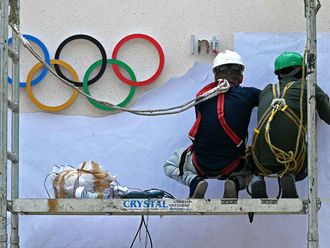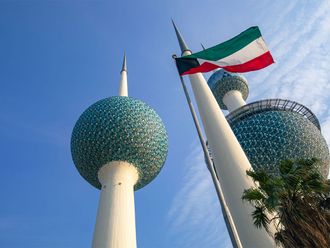
Agriculture can be a lonely endeavour but in the drought-hit belt of Marathwada, deep in the western Indian state of Maharashtra, women have been the driving force behind a new wave of sustainable farming.
That seems to have led to fundamental changes. In a reversal of tradition, women are injecting new ideas into family farms. And critically for this impoverished region, specks of green are visible, the women farmers have established supply chains at the market, and introduced vegetables to their humble dinner plates.
All of this was just a glimmer in the distant horizon few years ago, but sometimes effective empowerment is all a woman farmer needs to change her health, land and the environment.
In years following the droughts in Marathwada — the region faced 22 droughts in the last 140 years and the most recent one in 2014-15 — and increasing food insecurity thereof, women were affected by chronic anaemia due to lack of basic nutrition. “Their overall well-being was drastically deteriorating, as they had no decision-making role in the family and farm — food to be grown and eaten,” says Prema Gopalan, founder of non-profit Swayam Shikshan Prayog (SSP). “But to earn money fast, male farmers were only interested in growing cash crops, instead of food crops.”
-Prema Gopalan, SSP
In climate-threatened regions of Maharashtra, Gopalan says, marginal farmers reliant on commercial cultivation are at a greater economic risk due to their water-intensive crops and excess use of chemical fertilisers and pesticides. “Despite recurrent droughts and yield loss, men farmers failed to understand the shifts they needed to make.”
And, often bankrupt and stricken with debt, thousands resorted to what they believe is the only way out: suicide.
“However, as sole or principal caregivers, the burden of providing food for the households was on women, who were stressed because of the growing adversities.”
Women have never been strangers to farm work in India, says Gopalan, who has spent the last 20 years working in rural heartland. “In rural India, 83 per cent of women are actively engaged in agriculture compared to only 67 per cent of men. Notwithstanding their immense contribution, women are only seen as casual labourers.”
The statistics are well-known. Women have fewer rights than male farmers, and face extreme disadvantages in terms of pay, land ownership and access to technology.
To empower women who tend to family and the farm — and to alleviate hunger in the process — it is crucial to bring them at the centre of their family and community, says Gopalan, and remove the obstacles that hinder them from taking charge of their lives.
In 2011, she found out how best to close the glaring gap that exists on India’s farms. An innovative, water-efficient climate resilient farming model was devised by SSP for women farmers that promoted bio-fertilisers, diversification of food crops, water conservation, tree plantation and sustainable allied agribusiness. And women were trained with the help of experts.
“This initiative repositioned them as farmers, enabling them to take informed decisions on what to grow, what to consume and how much to sell,” says the sustainable farming advocate. “It addressed the issues of food and income security, natural resource management and empowerment — all at the same time.”
Bio-farming
In a region where farmers grow water-intensive crops such as sugarcane, wheat, cotton and soya, SSP’s proposal of starting with just one acre farmland and grow more than 25 food crops throughout the year struck a chord.
It started with just a hundred women farmers, and now tens of thousands have adopted it, and it’s not hard to see why. Switching over from expensive method of chemical farming to low cost bio-farming has not just increased their income — about Dh1,833 annual savings per household due to food from farm — and productivity by 25 per cent per acre, but a regular supply of green vegetables grown in their own farm has increased the immunity of their family.
Gopalan wanted as many women farmers as possible to reap the benefits of the training SSP offered. So farming groups were formed to allow those who had received training to share their learnings with other women farmers in their villages. “Our role is to create an enabling eco-system, develop successful farmers as leaders,” says Gopalan.
Now, along with farming, some women have started their own poultry and dairy business. With their increased economic status, there’s a change in their standing in the community. In Andur village, Vaishali Ghuge started vermicompost business, Shantabai Rathod of Nilegaon Tanda village is planning to build a new house, Anita Khanapur from Masala village is saving enough to educate her daughters.
“When an initiative shares technical knowledge and skills, then the change is transformative — women gain control over income, assets, and spend it on health and education,” says Gopalan.
“From a single identity as farm labour, women have now taken on multiple roles and gained new economic and social identities, as a farmer and decision maker in her household, as an entrepreneur, a grassroots advocate and a climate leader,” says Gopalan, who founded SSP to empower women with leadership and entrepreneurial skills in 1998, prompted by the powerful earthquake that hit Latur and Osmanabad in 1993.
“That earthquake laid our foundation,” she adds. “Sometimes disasters offer opportunities.”
Interestingly, SSP’s initiative has also has given the “invisible” women farmers a face: Godavari Dange, a marginal farmer who in 2012 mobilised more than 1,000 women farmers across 110 villages – when the Marathwada region faced a severe drought — to collectively grow food crops to improve food security is now a goodwill ambassador in the UN for the International Fund for Agricultural Development. “Godavari is a global leader changing the lives of farmers in her village and beyond,” says Gopalan. “Godavari and many others like her are the change agents.”
Perhaps the greatest benefit of the initiative, according to her, is something that cannot really be measured: solidarity, of “hand holding support and mentorship”.
In the countryside in India, women work alone, cut off from everyone else and the isolation of smallholder farmers is easily overlooked. Bringing them together in a group, SSP has created an entirely different dynamic, says Gopalan. “They gained confidence.”
In the last seven years, SSP’s farming outreach has swelled into a gale force, transforming the lives of nearly 41,000 marginal women farmers, and converting 30,000 acres of parched land into bio farms. Over the last few years, the women farmers have earned a revenue of Dh26.52 million as the cost of production of food crops is less than cash crops, says Gopalan.
But with over 60,000 farm suicides since 1995, can this initiative end deaths in the hinterlands?
“When we started working with women farmers, giving up was not an option as they focused on food and income security,” says Gopalan. “The initiative has created a major impact in the marginal farming households, and can be definitely applied to tackle this scourge.”
The innovative farming model, which has been implemented in almost 2,000 environmentally vulnerable villages in Gujarat, Tamil Nadu and Bihar, won the United Nations Development Programme’s Equator Prize 2017 and the UN Climate Solutions Award in 2016.
To Gopalan, assisting farmers is about more than just providing them with resources; it’s about helping them understand their circumstances and choose the best solutions for themselves and their families. There’s no magic bullet.
Now, Gopalan wants to push corporations and the government to invest in manufacturing women-friendly tractors and threshers that not only save labour cost, improve productivity “but also opens up entrepreneurial avenues for women”.
Research shows that putting female farmers in control of resources benefits the nutrition of family and Gopalan’s observations bear this out. “Women follow the principle that the needs of the families in the group come first,” she says. “Only what’s left over goes to the market. There’s no doubt that when women get greater rights in agriculture, things improve.”
“Our focus is to empower women to make all the important decisions on the farms they run, and own it in the truest sense, not just on paper,” she adds.
Suparna Dutt-D’Cunha is a writer based in Pune, India.












